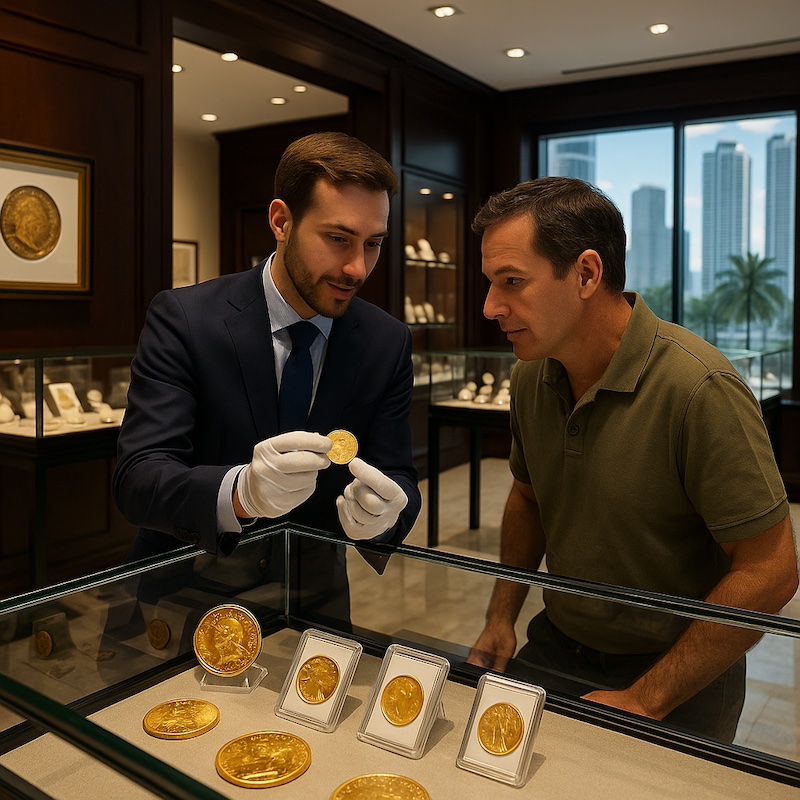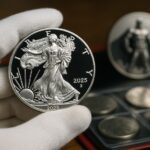If you only skimmed the latest Mint statistics, you might think September was a snooze. Headline numbers show U.S. Mint sales easing into a quiet patch, with most products posting modest gains and few breakout performers. But look a little closer and a different story emerges—one where selective demand, low-mintage gold and niche collectibles may set up tomorrow’s key coins.
For U.S. coin collectors, industry professionals and investors, understanding these softer months is just as important as tracking headline sell-outs. A “slow” report can signal where the real opportunities are hiding.
“Sales reports aren’t just scorecards,” as one market analyst recently put it. “They’re early signals of which coins the hobby might be talking about ten years from now.”
Let’s unpack what the latest numbers tell us and how they fit into the broader 2025 market.
TL;DR – Key Takeaways on U.S. Mint Sales
- September 2025 was a slow month for U.S. Mint sales, with most numismatic lines posting only incremental gains, confirming a broader cooldown seen in earlier 2025 reports.
- Two bright spots stood out: the 2025 American Liberty High Relief Gold Coin and its 1-oz silver medal counterpart, both of which saw sharp cumulative increases after strong August launches.
- Newly added American Women Quarters ornaments posted solid early numbers, helped by their final-year, low-limit status (2,500 units per design).
- Bullion coin demand from the Mint has been weaker overall in 2025, with analysts noting a sharp plunge in Gold and Silver Eagle sales compared to recent years as investors get pickier.
- For collectors, a quiet report doesn’t mean nothing is happening—it’s often when long-term sleepers and under-the-radar series are still available at issue price.
(This article is for educational purposes only and is not individualized investment or financial advice.)
U.S. Mint Sales in September 2025: A Seasonal Slowdown
The Numismatic News “Mint Statistics: Slow Month for Mint Sales” column summarizes what many dealers already felt on the bourse floor: September was subdued. Most commemorative and proof lines ticked upward only slightly, and there were no major new releases during the reporting window to jolt the charts.
This shouldn’t surprise experienced numismatists. Historically, U.S. Mint demand tends to:
- Surge in spring, when annual sets and early-year commemoratives debut.
- Spike in late summer, when headline programs like American Liberty, special Silver Eagles or limited gold issues launch.
- Enter a late-summer/early-fall lull before year-end releases and gift buying pick up.
CoinNews’ weekly sales coverage noted that earlier in 2025, the Mint enjoyed a five-week streak where close to 100 products showed week-over-week gains—but that momentum had already slowed by mid-summer.
When you combine that seasonal pattern with softer bullion demand (more on that later), a quiet September for U.S. Mint sales looks more like a normal breather than a crisis.
American Liberty Gold Coin: A Standout in a Quiet Month
Among the few bright spots in the latest report, the American Liberty 1-oz gold coin and its silver medal counterpart stand out.
The 2025-W American Liberty High Relief $100 gold coin features a sunflower and honeybee motif, struck in .9999 fine gold with a mintage limit of just 12,000 pieces—the lowest in the American Liberty gold series to date.
According to CoinNews, in its launch week the gold coin recorded 7,350 sales, while the 1-oz silver medal logged 28,888 units, making them two of the Mint’s most sought-after products in late August.
By mid-September, Mint statistics showed:
- Continued incremental gains in cumulative sales for both pieces
- Strong enough demand that many dealers began to speculate about a potential sell-out for the gold coin, given its low ceiling and past performance of low-mintage American Liberty issues
A forum analysis of previous American Liberty 1-oz gold coins underscores why collectors are watching closely. Earlier releases with mintages around 49,000 generally trade near bullion value, while more recent issues limited to roughly 12,000 pieces command noticeably higher premiums on the secondary market.
In other words, even in a slow month, the Mint statistics hint that the 2025 American Liberty gold could become one of the key modern U.S. gold issues if final sales land at or below its already modest limit.
American Women Quarters Ornaments: Low-Limit Sleeper Series
Another area of activity in the September U.S. Mint sales report was the newly-added line of American Women Quarters ornaments.
The U.S. Mint’s press release announced that the 2025 American Women Quarters Ornaments™—each containing a 2025 quarter with uncirculated finish—went on sale August 26 with no household order limits and a production cap of 2,500 units per design.
Key context for collectors:
- The ornaments are tied to the broader American Women Quarters Program, a four-year run (2022–2025) honoring 20 trailblazing American women.
- 2025 is the final year of the program, giving these ornaments “last-of-series” appeal—historically a strong driver of demand for sets and related collectibles.
Market writers have already flagged the ornaments as a low-limit, specialized series that could interest both quarter specialists and holiday-themed collectors.
While September’s Mint statistics don’t show explosive numbers yet, early adoption combined with the small per-design cap suggests these could quietly disappear into collections, leaving latecomers chasing them on the secondary market.
U.S. Mint Sales Trends and the 2025 Bullion Slump
Not all of the story is positive. For industry professionals and investors, the more concerning trend is the broader 2025 bullion sales slump.
- Independent analysis of Mint bullion data shows sharp declines in Gold and Silver American Eagle sales in the first half of 2025 compared to the pandemic-era boom years.
- Buyers have become more selective, often preferring secondary-market coins, world bullion issues, or lower-premium rounds over freshly minted Eagles.
This environment helps explain why some numismatic products may be seeing softer add-on sales: when investors are cautious, they’re less likely to grab every new release.
At the same time, U.S. Mint sales of premium products like the American Liberty gold and specialized series like the Comic Art coins (the next issue due after this report) show that collectors will still pay up—when the design, theme and mintage align. coinnews.net+1
How Mint Statistics Help Collectors and Investors
Mint reports and third-party U.S. Mint sales summaries aren’t just interesting reading; they’re practical tools.
For coin collectors and numismatists
- Gauge scarcity in real time – Weekly or monthly cumulative figures indicate whether a product is trending toward sell-out or lingering on the shelves.
- Spot under-the-radar items – Modest but steady growth in low-mintage items (like ornaments or medals) can signal sleepers.
- Plan sets and series – Knowing how the Mint treats final-year issues, special finishes, or tie-in products helps you decide which lines to complete.
For coin investors and dealers
- Inventory decisions – Sales data guides how much to stock of a new release, and when to shift from primary to secondary market buying.
- Premium analysis – Comparing mintage limits, actual sales and aftermarket behavior (as with American Liberty gold) helps estimate long-term premium potential.
- Client education – Hard numbers make it easier to explain why one modern issue has room to grow while another may remain essentially bullion.
Of course, sales numbers are only one input. Grading quality, eye appeal, overall series popularity and broader economic conditions all matter. But ignoring Mint statistics is like flying without instruments.
Pros and Cons of Buying During a Slow Mint Month
Potential Advantages
- Less competition at launch – Quiet months often mean less website traffic, fewer order cancellations and less “FOMO” bidding on day one.
- Time to research – Without the frenzy of a hyped sell-out, collectors can read mintage details, study past series and decide rationally.
- Better secondary-market deals – Dealers who over-ordered may discount inventory later in the year, especially before new product schedules hit.
Potential Risks
- Buying into a lagging series – Some products are slow for a reason; demand may remain weak long term.
- Opportunity cost – Funds tied up in underperforming issues can’t be deployed into genuinely scarce or high-demand coins.
- Overemphasis on modern mintages – Focusing solely on fresh products can distract from classic material (key-date Morgans, early gold, etc.) with long-proven markets.
A balanced approach is to treat modern Mint statistics as a tactical tool while keeping your overall collection strategy diversified across eras and denominations.
These internal links help readers drill deeper into the topics that interest them, while reinforcing topical authority around U.S. Mint sales and modern numismatics.
FAQ: U.S. Mint Sales and September’s Slowdown
1. Are slow U.S. Mint sales a sign that the hobby is in trouble?
Not necessarily. Mint demand is cyclical. 2025 has seen softer bullion sales and fewer blockbuster launches, but auction activity and high-end rare coin prices remain strong. Slow periods often reflect poor product mix and macroeconomic caution more than a structural decline in numismatics.
2. Is the 2025 American Liberty gold coin likely to sell out?
With a 12,000-coin mintage limit, strong launch numbers around 7,350, and precedent for low-mintage Liberty coins trading at premiums, many analysts believe a sell-out or near-sell-out is plausible—though not guaranteed.
3. Are American Women Quarters ornaments a good long-term buy?
They’re a niche product with low limits (2,500 each) tied to a historic, four-year program ending in 2025. That combination gives them collectible appeal, but long-term value will depend on how many collectors ultimately build full sets and how widely the series is appreciated.
4. Where can I find official Mint statistics?
The U.S. Mint posts weekly cumulative sales figures on its website, and sites like CoinNews and USA Coin Book aggregate and analyze the data in user-friendly formats.
5. Should I buy coins directly from the Mint or from dealers?
Both have pros and cons. Buying from the Mint guarantees authenticity and original packaging at issue price, but some items later sell below issue on the secondary market. Dealers can offer discounts, graded coins and older issues, but spreads and premiums vary. For high-value decisions, compare both sources and consider advice from trusted professionals.
Conclusion: Reading Between the Lines of a “Slow” Mint Report
On paper, September 2025 may look like a dull chapter in the U.S. Mint sales story. In reality, it’s a revealing snapshot of a maturing market:
- High-concept, low-mintage offerings like the American Liberty gold coin continue to attract serious attention.
- Specialized programs such as American Women Quarters ornaments are quietly building followings among focused collectors.
- Bullion buyers are choosier, pushing the Mint to innovate while creating opportunities in neglected corners of the product line.
For coin collectors, industry professionals and investors, the lesson is clear: don’t dismiss a Mint report just because the headline says “slow month.” That’s often when the future sleepers are still available, waiting for someone with a long view—and a good understanding of Mint statistics—to pick them up.
If you haven’t already, consider making Mint sales reports part of your regular collecting routine. Pair them with independent research, a sound budget and advice from trusted numismatic professionals, and you’ll be better positioned to navigate both the quiet months and the sell-out frenzies that define modern U.S. coinage.







